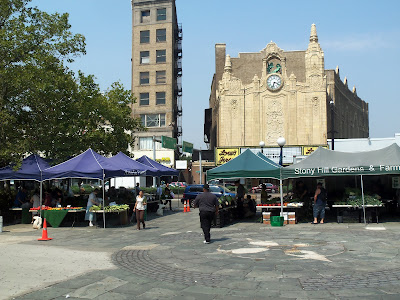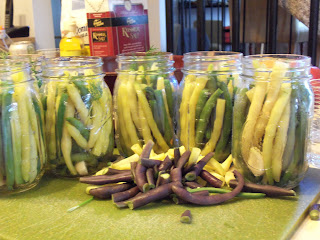 |
| Jackie Robinson played ball here in 1946 at Roosevelt Stadium, Jersey City. |
It's August and the last month of summer is here. The farms are overflowing with corn, tomatoes, cukes, peppers, eggplants, zucchini - all the late summer crops - lettuces, beets and spinach, bokchoy, are still strong and the fruit crops have turned away from berries to stone fruits and melons. There is a farmers' market in Jersey City every day of the week, and the Friday market is held at Journal Square. In search of more delicious string beans and ripe tomatoes,
I ventured out to the PATH Plaza at the intersection of Kennedy Blvd and Bergen St. This location operates on Wednesdays and Fridays, and features the two big farmer's stands, Stony Hill Gardens, and Alstede's. They were rather evenly matched for produce, quantity, prices.
 |
| The historic Loew's Theater stands proudly behind the canopied farmers. |
 |
| The fountain is dry. |
The next day, my two friends and I set to work on a trio of recipes. We made a peach-cardamom jam, Moroccan-style preserved lemons, and dilly beans. The peach cardamom jam was almost preserves like in texture, and a bold spicy taste. The goal was to make a product that was lower in sugar and pectin, and this is what we did.
Ingredients:
6 lbs of peaches
4 lbs sugar
3 tablespoons dry pectin ( 1 box)
1/4 cup lemon juice, fresh
1/4 teaspoon ground cardamom
Peel the peaches, and slice them into small pieces. We wanted a chunky texture. Put them into a very large preserving pan or dutch oven, and add the lemon juice. Cook over high heat until the fruit boils. Then add the pectin and the sugar. Bring to a boil again stirring well to dissolve the sugar. Add the cardamom and cook until the color darkens a little and the syrup thickens. Test for jell. Add a little more cardamom if you like. If the jam is too runny, cook at a steady boil for another four or five minutes, testing every 2 minutes. Yield: 8 half pints.
 |
| We love the widemouth short half pint Ball jar. |
 |
| A jar packed with lemon rinds, waiting to be filled and capped |
.JPG)
Cutting, rolling and juicing 2 dozen lemons.
 |
| The basic jar of string beans ready for different flavors. |



